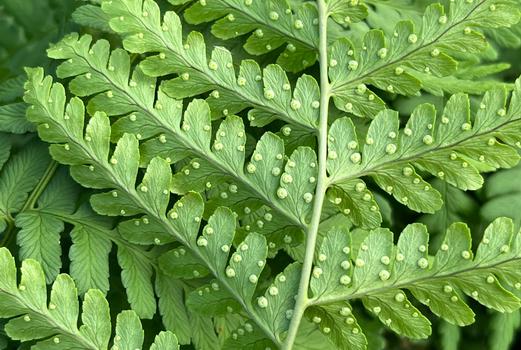Fern Facts
It’s native fern week! It’s been a while since we’ve explored some of the diverse and fascinating fern species that we have in abundance here at the Nursery, so this week we’re paying homage to these prehistoric plants and their often unseen and underappreciated attributes. Through a brief journey into the physiological, ecological, cultural and historical uses of these North American native ferns, we hope to leave you loving them as much as we do!
At first glance and to the untrained eye, fern fronds may look all the same. But there are distinct physiological differences that establish one from the other, even those in the Dryopteris genus that may initially appear to be indistinguishable. For example, our native marginal wood fern, Dryopteris marginalis is a beautiful, shade-loving evergreen fern with deeply lobed fronds that feature sori on the margin of individual pinnules (what might be considered a leaflet on a compound leaf). The marginal location of the sori is how this deer-and-rabbit-resistant fern gets its name, acting also as a wonderful identifying marker along with its clumping habit when looking for this plant out in its natural habitat.
Meanwhile, the Dixie wood fern, Dryopteris australis belongs naturally to much of the Southeastern region of the United States and is becoming more infrequent in its own habitat. It is found to be a hybrid cross between North American wood ferns Dryopteris celsa and Dryopteris ludoviciana, although it is mostly sterile and limited in its reproductive abilities hence, perhaps, its limited natural distribution. Unlike its marginally-spored cousin, Dixie wood fern has a broader clumping habit and is capable of a slow and nonthreatening spread by short underground rhizomes. Despite Dryopteris harboring upwards of 250 species that are primarily endemic to Asia, North America is home to a known 14 species in the genus, suggesting evolutionarily that there was likely some wood fern migration in the Pleistocene glaciations – that’s right, we can trace Dryopteris back about 2.6 million years (Mink et al., 2010).
If you think that’s impressive, though, the fossil record of the ferns in Osmundaceae, specifically cinnamon fern (Osmunda cinnamomea) and royal fern (Osmunda regalis) are found to be some of the oldest known fern fossils on Earth, dating back to approximately 250 million years ago. With the impressive, large stature of the aptly named royal fern, one might be able to imagine huge, 3-foot-long fronds of the stately 6’ tall fern swaying gently in prehistoric breezes against the legs of animals only just barely recognizable to our modern eyes.
Another easily identifiable native to temperate woodlands and rocky forest outcroppings is Polystichum acrostichoides, known commonly as the Christmas fern primarily for its dark green sterile fronds that remain persistent through the winter, and were often utilized in holiday decorations to contrast red holly berries and brown cones. If one wants to get really creative with identifying this plant by its common name characteristic, make sure to look for the shape of the individual pinnae, which resemble the shape of a classic Christmas “stocking”. Although this particular fern is known to have somewhat limited faunal associations, the young crosiers are occasionally grazed by hungry gamebirds such as Ruffed Grouse, while the sterile evergreen fronds may be picked through my desperate deer in winter months after the fertile fronds have died back.
Another dimorphic fern species that also has an affinity for rich, mesic, woodland soils as well as low-lying, well-saturated soils is the Ostrich fern, Mattueccia struthiopteris. The impressive height and range of this easily-spreading fern makes for a great backdrop to smaller shade-loving perennials, and acts as a protective shelter for small mammals and birds. The emerging fiddleheads are a fantastic source of nutrients not only for grazing animals, but for humans as well – they are loaded with essential omega-3 fatty acids, so many in fact that one study found that eating “three to four cups of cooked ostrich ferns” was comparable to fatty acid content of found in a diet of fish and nuts (Delong et al., 2011). The same study found that Ostrich fern fiddleheads are abundant in antioxidants, making it altogether a nutritious and healthful culinary resource. Which is helpful for when fiddleheads may pop up in unwanted places in the spring – you don’t have to feel bad for eating them!
Adirondacks Forever Wild. (n.d.). Ferns of the Adirondacks: Royal Fern (Osmunda regalis var. spectabilis). Royal Fern | Osmunda regalis. https://wildadirondacks.org/adirondack-ferns-royal-fern-osmunda-regalis.html
Delong, J., Hodges, D. M., Prange, R., Forney, C., Toivenon, P., Bishop, M. C., Elliot, M., & Jordan, M. (2011). The Unique Fatty Acid and Antioxidant Composition of Ostrich Fern (Matteuccia struthiopteris) Fiddleheads. Canadian Journal of Plant Science, 91(5), 919–930. https://doi.org/10.4141/cjps2010-042
Galloway, H. (2014, June 25). Christmas fern. Christmas Fern | Mountain Lake Biological Station, U.Va. https://mlbs.virginia.edu/organism/polystichum_acrostichoides
Hardy Fern Foundation. (2020, December 17). Polystichum acrostichoides. Hardy Fern Foundation. https://hardyferns.org/ferns/polystichum-acrostichoides/
Hilty, J. (2019, November 20). Ostrich Fern | Matteuccia struthiopteris. Illinois Wildflowers. https://www.illinoiswildflowers.info/grasses/plants/ostrich_fern.htm
Hilty, J. (2019a, November 20). Christmas fern (polystichum acrostichoides). Illinois Wildflowers. https://illinoiswildflowers.info/grasses/plants/christmas_fern.htm
Johnson, W. Hilton (2023, June 1). Pleistocene Epoch. Encyclopedia Britannica. https://www.britannica.com/science/Pleistocene-Epoch
Mink, J. N., Singhurst, J. R., & Holmes, W. C. (2010). DRYOPTERIS MARGINALIS (DRYOPTERIDACEAE): NEW TO TEXAS . Phytoneuron, (53), 1–6. https://www.phytoneuron.net/PhytoN-Dryopterismarginalis.pdf
N.C. State Extension. (n.d.-a). Dryopteris australis. Dryopteris australis (Dixie Wood Fern) | North Carolina Extension Gardener Plant Toolbox. https://plants.ces.ncsu.edu/plants/dryopteris-australis/
N.C. State Extension. (n.d.-b). Dryopteris marginalis. Dryopteris marginalis (Evergreen Woodfern, Leather Wood Fern, Marginal Woodfern, Marginal Wood Fern) | North Carolina Extension Gardener Plant Toolbox. https://plants.ces.ncsu.edu/plants/dryopteris-marginalis/
Pinson, J. (2021). About Ferns. American Fern Society. https://www.amerfernsoc.org/about-ferns/
See all our Ferns
Dryopteris marginalis








